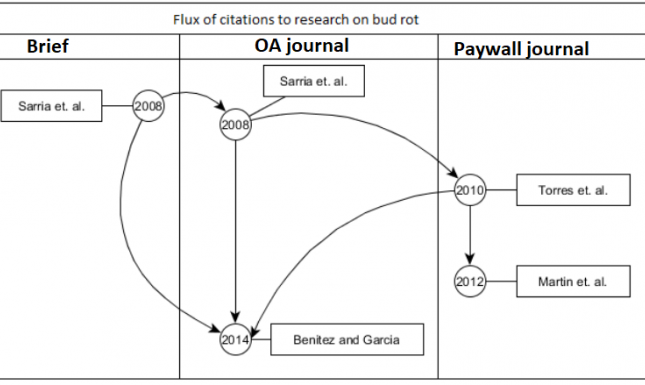Beyond Open Access articles: briefs can provide wider and faster access to scientific knowledge
Many journals are making research on COVID19 publicly available. This is valuable, but studies on usability of research suggest scientists need to develop media to quickly reach professional stakeholders. Diego Chavarro explains how briefs helped address faster the bud rot disease in palm oil.
Open Access (OA) is key to achieve a greater dissemination of knowledge among scholars. Its benefits are acknowledged and advocated by many researchers, universities, and funding agencies internationally. They have produced global manifestos and implemented collective actions to make publicly-funded research open. Latin America is an example of how OA can contribute to the dissemination of knowledge through OA journals and bibliographic databases such as Scielo and RedALyC.
However, access by itself does not guarantee a closer engagement between science and society at large, which it is the aim of Open Science (OS). In this post I reflect on a previous case study (Chavarro 2017; Chavarro, Tang, & Ràfols 2018), reinterpreted here to show how OA could be enhanced to increase its social impact. I also reflect on some challenges that the social impact of OA pose to science policy1.
The need for alternative publication formats
The Budapest Open Access Initiative understands OA as “world-wide electronic distribution of the peer-reviewed journal literature and completely free and unrestricted access to it by all scientists, scholars, teachers, students, and other curious minds”. Many initiatives – such as OA databases and institutional repositories – provide access to this peer-reviewed literature, mainly to research articles.
However, it is well-known that research articles are written in technical language that is not “accessible” to everyone. In many cases, these articles are too technical for the people who could benefit the most from the research, such as farmers and other stakeholders. If we take into account that a lot of the academic literature is published in English, even if those stakeholders had free access to the papers they would face a big linguistic barrier to use that knowledge.
Such is the case of bud rot disease research. This disease affects the African oil palm, which is grown in countries in the equatorial belt such as Colombia, Malaysia, Indonesia, Thailand, and Nigeria. It is a large-scale crop that provides employment comparable to crops such as soybeans. Due to its economic importance, diseases that affect the plant have large consequences for employment. For this reason researchers on bud rot need to make sure that their findings reach people outside academia.
Bud rot kills the plant completely and leaves it unproductive. One of the main problems is that there is uncertainty about the cause of the disease. In Colombia, researchers at Cenipalma – a research institute for the study of Palm – found evidence that bud rot is caused by a type of mould called phytophtora palmivora.
An analysis of this research on the causes of the disease by Cenipalma’s researchers showed that it was first published as briefs for farmers instead of academic publications. The following figure shows this team published results about bud rot early as a brief and it was only later that they published in OA and later to paywall journals.

When asked about the reasons why the results were published initially as briefs, a researcher said that their priority is “contributing to the improvement of farmers' quality of life”. Another researcher said:
An interviewee deepened in the explanation for their choice of publication media:
Therefore, in this case the researchers published briefs because of their proximity to the readership they wanted to reach and also because they do not have the pressure to publish in high-impact journals. They chose an accessible – in the sense of non-formal scientific communication – format to ensure use of their knowledge beyond academia.
Some policy challenges
The case of bud rot disease shows some demands of researchers from Open Access (OA) in an age of Open Science (OS). Basically, researchers need venues to publish research that can be accessed, understood, and used by stakeholders beyond academia. The case indicates that OA – understood as access to peer-reviewed literature – is necessary but not sufficient to improve the use of scientific knowledge in society, which is an aim of OS. OS, then, poses important communication challenges.
These challenges extend to public policy for OA. Although many public institutions promote free availability of research papers, this promotion is based on a generic understanding of the readers. Basically, OA policies assume that the readers of scientific research are scientists with the same capabilities and interests as those who publish the papers. This assumption is incorrect, because from an OS perspective the readership of scientific research includes not only scientists, but also people in governments, companies, and other social groups – as shown by the case in this post. It also overlooks the imbalances that exist within the global scientific community, in which some countries concentrate high capabilities and resources while others lie at the periphery in many fields.
For instance, researchers in Colombian universities will face barriers to reproduce OA results and methodologies published by researchers in the pharmaceutical industry in the USA and Germany because they lack key equipment, reagents, proximity to suppliers, etc. Therefore, scientific capabilities are not uniform across regions.
Readership and disparities within the scientific community point out the need to develop a more comprehensive approach to OA. If OA policies are to contribute to OS, they need to explicitly support the production of information for different types of readers (scientists and non-scientists), ensure that research on relevant subjects find suitable publication venues, and complement OA policy with support for infrastructure, international collaboration, and capabilities development. Otherwise the benefits of OA for many countries, especially those with low investment on science, technology, and innovation, will be yet another unfulfilled dream.
From the point of view of journal promotion, the cases show the need to identify and foster communication channels and local journals that are underestimated by current research evaluation systems (Chavarro, Ràfols, & Tang 2018). Given that these systems are mainly based on standardized – as opposed to diverse – ways of valuing contributions to knowledge, OS can be hindered, contradicting stated governmental intentions to support it. Therefore, if OS is to be fostered, research evaluation systems should be transformed to be in agreement with these intended policies.
A way to support the development of journals and alternative communication channels that contribute to OS is by better understanding in which ways they can contribute to the economy, the environment, and social issues. This requires research on the communicative functions of science that go beyond academic prestige and scientific impact, especially in the applied and social sciences. For instance, neglected diseases is a subject of clear importance for many countries in which fostering new communication functions is needed. Therefore, regions such as Latin America could allocate funding for research on the communicative functions of science to foster OS.
One can think of other demands related to the above: diversity of languages, gender, geography, among others, play an important role in achieving a closer engagement between science and society. Recognizing and promoting this diversity as part of scientific communication goes in the direction of OS, and provides a way to reinterpret OA from a business model for academic diffusion to an integral mode of knowledge production and communication.
1 The data was gathered through interviews with researchers from agricultural sciences, chemistry, and business & management in Colombia. The interviews were aimed at understanding their motivations to publish in journals that are not considered part of the mainstream, specifically journals in Spanish or Portuguese managed mainly by universities instead of publishing houses.



0 Comments
Add a comment